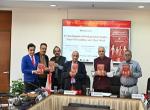The Vivekananda International Foundation (VIF) organised a lecture by Dr. Shashibala, Dean at the Centre of Indology, Bhartiya Vidya Bhavan, New Delhi, the topic being, ‘Indian Impact on Chinese Art’. Dr. Arvind Gupta, Director, VIF, chaired the proceedings. There are various aspects of Chinese art where Indian impact is clearly visible, however, due to the wide range of Chinese arts, Dr. Shashibala’s presentation mainly focused on sculptures.
It was stated that when Buddhism reached to China, a clear shift from building tombs to erecting temples, monasteries, stupas etc. was noticeable in archeological sources. Before Buddhism reached China, Chinese arts were more of existential nature than being transcendental.
A number of sculptures have been found in the various caves in China’s northwestern province of Xinjiang. These sculptures were created mainly by taking inspirations from the Buddhist philosophies and objects being brought form India to the China, said Dr. Shashibala. The quality and technology of making these sculptures changed according to the time period. Chinese did not have cult images before Buddhism reached China. After Buddhism reached here, it acquired royal patronage and it further led to the impact of Buddhism on Chinese arts. Although the Chinese believed in Samsara> and Nirvana but they did not believe in Sanyas. This phenomena is quite visible in Chinese art as well.
Buddha images and Buddhist symbols were produced in China in a scale that indicated a great impact of Indian traditions and arts. While explaining the importance of the caves Dr. Shashibala told that these caves are a great source of historical evidences depicting Indian influence. She has also emphasised on the Philosophical importance of these sculptures inside the caves in China. Caves in China are mainly situated along the ancient Silk Route through which Buddhism and Buddhist philosophies travelled from India to China and further to other places of the world. India is the spiritual leader of the world and Indian impact in China’s Buddhist art and architecture is a fine example of it told Dr. Shashibala.
While explaining the importance of the caves, Dr. Shashibala said that these caves were a great source of historical evidences depicting the Indian influence. She also emphasised on the philosophical importance of these sculptures in the Chinese caves. Caves in China are mainly situated along the ancient Silk Route through which Buddhism and Buddhist philosophies travelled from India to China and further to other places of the world. India is the spiritual leader of the world and Indian impact in China’s Buddhist art and architecture is a fine example of it, averred Dr. Shashibala.






Post new comment